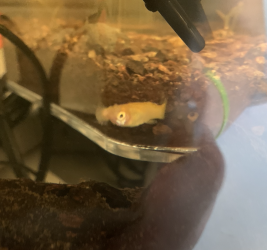BreeRelli
New Member
Hello!
I recently adopted a few female guppies. One of them, Cephia, is dealing with some fungus around her mouth.
She is in a 1-gal hospital tank being treated with Kanaplex. Today is the 4th day. I gave the second dose yesterday.
Yesterday she was looking great, back to eating, swimming around, and nearly all the fungus was gone. This morning I woke up and she looked like this, the fungus returned (btw, in photo you're also seeing through the hospital tank to the main aquarium). I'm wondering if any of this could be due to not offering the 2nd dose exactly 48 hours after the first—it was a few hours late.
Tested the water this morning, it reads:
Ammonia - 0
Nitrite - 0
Nitrate - 0
Ph - 7.4
Temperature 81.5-82.5
I have methylene blue and aquarium salt on hand, though I'm not sure if they can be used to help, or how.
Any help appreciated! I want to do everything I can to help her recover.
I recently adopted a few female guppies. One of them, Cephia, is dealing with some fungus around her mouth.
She is in a 1-gal hospital tank being treated with Kanaplex. Today is the 4th day. I gave the second dose yesterday.
Yesterday she was looking great, back to eating, swimming around, and nearly all the fungus was gone. This morning I woke up and she looked like this, the fungus returned (btw, in photo you're also seeing through the hospital tank to the main aquarium). I'm wondering if any of this could be due to not offering the 2nd dose exactly 48 hours after the first—it was a few hours late.
Tested the water this morning, it reads:
Ammonia - 0
Nitrite - 0
Nitrate - 0
Ph - 7.4
Temperature 81.5-82.5
I have methylene blue and aquarium salt on hand, though I'm not sure if they can be used to help, or how.
Any help appreciated! I want to do everything I can to help her recover.




